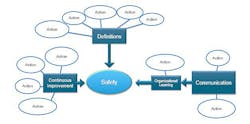Throw out your scale and stop weighing yourself. It’s not about the numbers; it’s about a lifestyle change.
Those of us who have tried to lose a few pounds likely have been given some version of that advice. And it is good advice. One of the main challenges that people face when trying to lose weight is being distracted – and frustrated – by the numbers. Yet, while the numbers on a scale can be frustrating, more importantly they can be a huge distraction from the real objectives that you may have.
Ultimately losing 10 pounds is not a problem statement. Losing 10 pounds, or lowering your blood pressure and any number of health benefits that people want to achieve are a result of a much bigger objective. That is a permanent lifestyle change, or a change in behavior.
If you stop focusing on numbers on a scale, you’ll note that fitness and health have many contributing factors. Nutrition, exercise, stress levels and sleep are just some of the contributing factors when it comes to fitness and, ultimately, weight loss. To successfully make permanent improvements in your fitness, you need to consider all of these factors and accept how they are interrelated. In other words, you need to understand the behavioral model that ongoing health and fitness requires.
It’s a hard message, but it’s a sensible approach to permanent behavior change.
It’s interesting that the world of safety is in a similar predicament to those of us trying to slim down. Many organizations end up singularly focused on granular metrics to measure safety. Be it incident rates, accident frequency, loss time at work or others. However, safety is more than just any one of these numbers.
Safety – and a culture of safety – for any organization really is the sum total of a number of factors all affecting day-to-day behavior. Accidents don’t just happen because of bad luck. All too often, accidents occur after periods of persistent unsafe behavior.
So, can we model out what the playbook or recipe for safe behavior is?
I think we can.
A Model for SafetyAny exercise in modeling behavior should take into account the unique variables that an organization may have. That being said, there are some common areas of influence that shared by nearly any organization.
The starting point for building out a model of safety for your organization is to look at those common elements. These include:
Definitions
How does your organization define safety? Clearly define expectations, policies and procedures. Do you have systems in place and provide your employees with easy access to controlled documents such as job safety analyses, risk registers and safety data sheets? As they say, knowing is only half the battle; writing down and making what you know accessible is the other half.
Communication
How are your organization’s expectations of safe behavior communicated through your organization? Do you include regular structured training for all team members so that they are aware of policies and procedures that apply organization-wide, as well as of the skills and certifications they may need for their specific roles? From on ongoing communication standpoint, does your organization reinforce this training with regularly occurring meetings? Safety meetings, executive meetings, stakeholder meetings and reviews all can be powerful tools to help maintain regular communication to reinforce your safety culture.
Organizational Learning
When issues arise or incidents occur, do you have a structured process and centralized system to log your incidents. Issues and incidents can happen at even the safest organizations, so when they do occur it is absolutely critical that the details of what happened are tracked and logged so that corrective actions can happen in real time, and ongoing analyses can happen to provide long-term improvements.
Continuous Improvement
Any behavioral change exercise, including those related to safety, has to involve ongoing evaluation and re-evaluations. Audits, formal inspections and reporting incidents of nonconformance can be powerful tools in tracking your safety initiatives in both a qualitative and quantitative way. These pools of data not only can be used to evaluate the current state of your safety culture, but can be data points used to forecast ongoing opportunities for improvement as well.
Your organization may have other contributing factors to your safety culture but these four foundational pillars are a great starting point. Remember, changing behaviors is more than just tracking any individual metric. It’s an exercise in understanding all of the interrelated elements and turning each of these individual dials in a way that results in the sum performing better than any one of the individual parts.
This post appeared originally on the Intelex Health and Safety blog.

